A New Low-Cost HW-Counterbased RowHammer Mitigation Technique
A technical paper titled “ABACuS: All-Bank Activation Counters for Scalable and Low Overhead RowHammer Mitigation” was presented at the August 2024 USENIX Security Symposium by researchers at ETH Zurich.
Abstract:
“We introduce ABACuS, a new low-cost hardware-counterbased RowHammer mitigation technique that performance-, energy-, and area-efficiently scales with worsening RowHammer vulnerability. We observe that both benign workloads and RowHammer attacks tend to access DRAM rows with the same row address in multiple DRAM banks at around the same time. Based on this observation, ABACuS’s key idea is to use a single shared row activation counter to track activations to the rows with the same row address in all DRAM banks. Unlike state-of-the-art RowHammer mitigation mechanisms that implement a separate row activation counter for each DRAM bank, ABACuS implements fewer counters (e.g., only one) to track an equal number of aggressor rows.
Our comprehensive evaluations show that ABACuS securely prevents RowHammer bitflips at low performance/energy overhead and low area cost. We compare ABACuS to four state-of-the-art mitigation mechanisms. At a nearfuture RowHammer threshold of 1000, ABACuS incurs only 0.58% (0.77%) performance and 1.66% (2.12%) DRAM energy overheads, averaged across 62 single-core (8-core) workloads, requiring only 9.47 KiB of storage per DRAM rank. At the RowHammer threshold of 1000, the best prior lowarea-cost mitigation mechanism incurs 1.80% higher average performance overhead than ABACuS, while ABACuS requires 2.50× smaller chip area to implement. At a future RowHammer threshold of 125, ABACuS performs very similarly to (within 0.38% of the performance of) the best prior performance- and energy-efficient RowHammer mitigation mechanism while requiring 22.72× smaller chip area. We show that ABACuS’s performance scales well with the number of DRAM banks. At the RowHammer threshold of 125, ABACuS incurs 1.58%, 1.50%, and 2.60% performance overheads for 16-, 32-, and 64-bank systems across all single-core workloads, respectively. ABACuS is freely and openly available at https://github.com/CMU-SAFARI/ABACuS.”
Find the technical paper here.
Olgun, Ataberk, Yahya Can Tugrul, Nisa Bostanci, Ismail Emir Yuksel, Haocong Luo, Steve Rhyner, Abdullah Giray Yaglikci, Geraldo F. Oliveira, and Onur Mutlu. “Abacus: All-bank activation counters for scalable and low overhead rowhammer mitigation.” In USENIX Security. 2024.
Further Reading
Securing DRAM Against Evolving Rowhammer Threats
A multi-layered, system-level approach is crucial to DRAM protection.
The post A New Low-Cost HW-Counterbased RowHammer Mitigation Technique appeared first on Semiconductor Engineering.


